HRM Presentation: Talent Management and Employee Retention Strategies
VerifiedAdded on 2023/01/09
|7
|1092
|54
Presentation
AI Summary
This presentation analyzes the impact of talent management on employee retention, drawing from the research of Oladapo (2014). The study, employing a causal comparative method and survey technique, investigated the relationship between talent management programs and employee retention rates across 200 business organizations. The findings highlight the importance of talent management in achieving better stakeholder results and the significance of both tangible and intangible factors, such as work-life balance and career development, in employee retention. The research reveals that while compensation initially attracts employees, factors like job security and opportunities for growth are crucial for long-term retention. The conclusion emphasizes the need for organizations to prioritize talent development and retention strategies to address the challenges of a changing demographic and the increasing difficulty in replacing skilled workers. The presentation underscores the importance of HR personnel recognizing the dependency of employee retention rates on the talent management strategies implemented by an organization.

Talent Development and Retention
Name:
Student number :
Campus:
Lecturer/tutor :
Name:
Student number :
Campus:
Lecturer/tutor :
Paraphrase This Document
Need a fresh take? Get an instant paraphrase of this document with our AI Paraphraser
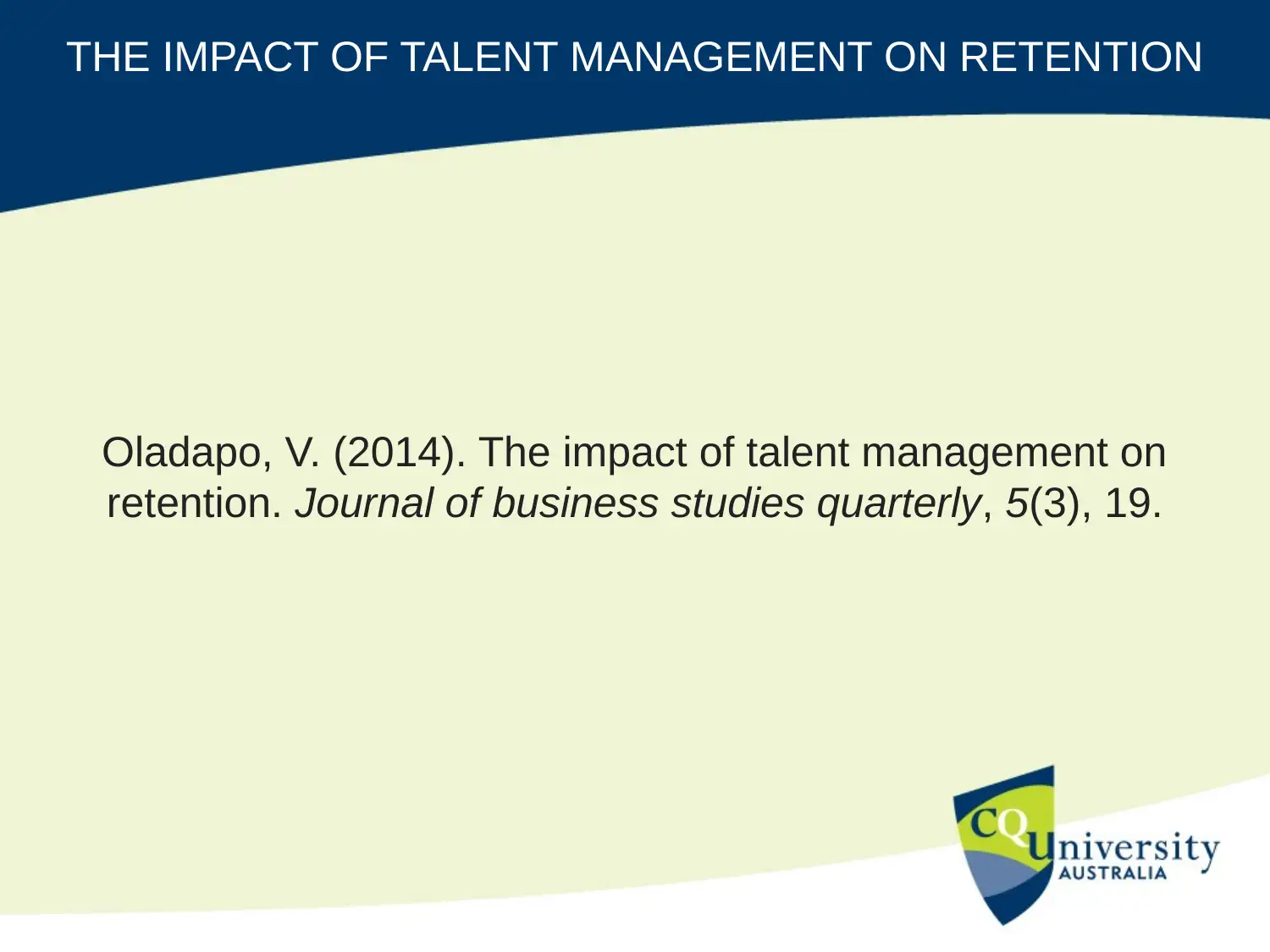
THE IMPACT OF TALENT MANAGEMENT ON RETENTION
Oladapo, V. (2014). The impact of talent management on
retention. Journal of business studies quarterly, 5(3), 19.
Oladapo, V. (2014). The impact of talent management on
retention. Journal of business studies quarterly, 5(3), 19.
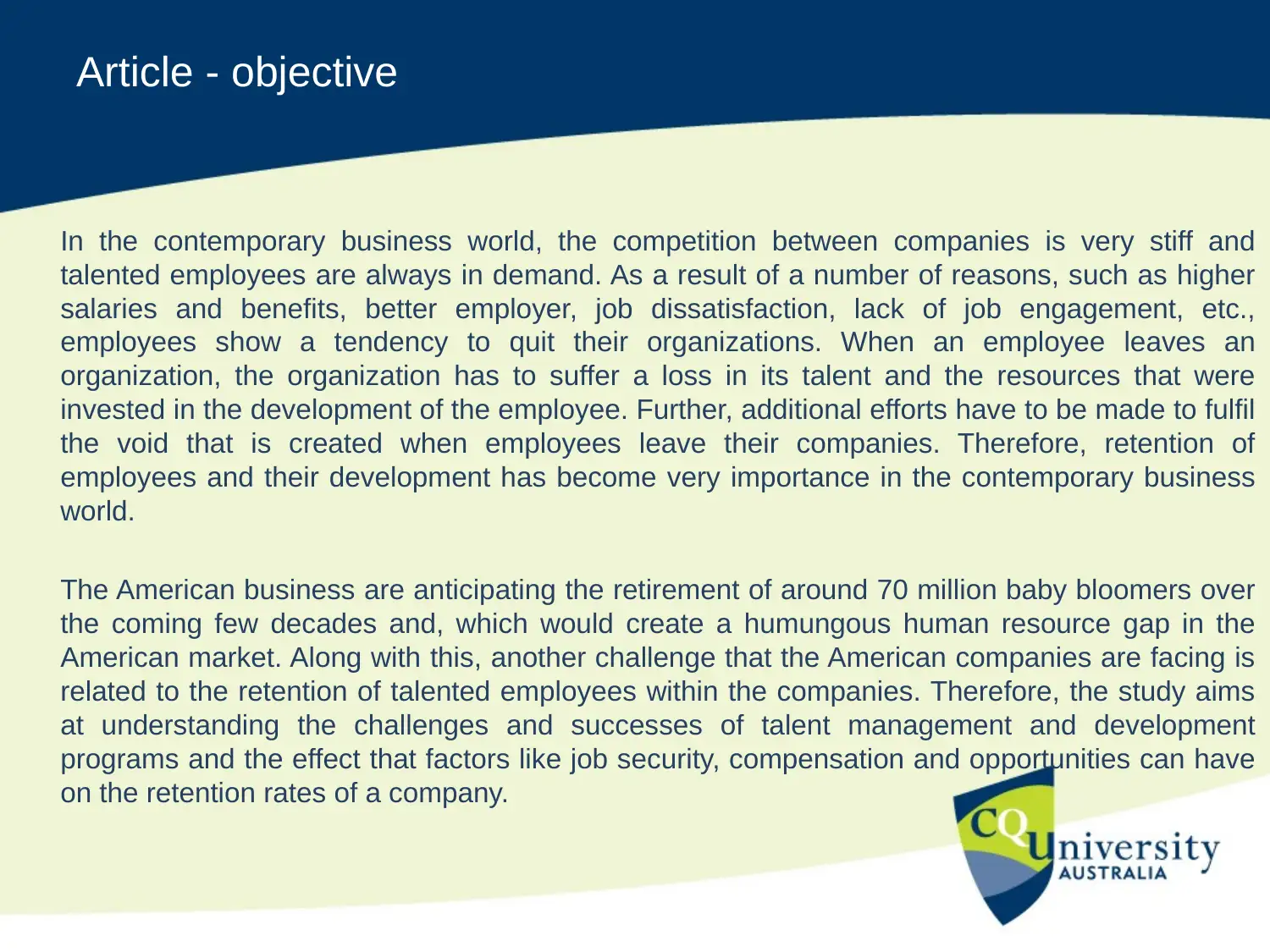
Article - objective
In the contemporary business world, the competition between companies is very stiff and
talented employees are always in demand. As a result of a number of reasons, such as higher
salaries and benefits, better employer, job dissatisfaction, lack of job engagement, etc.,
employees show a tendency to quit their organizations. When an employee leaves an
organization, the organization has to suffer a loss in its talent and the resources that were
invested in the development of the employee. Further, additional efforts have to be made to fulfil
the void that is created when employees leave their companies. Therefore, retention of
employees and their development has become very importance in the contemporary business
world.
The American business are anticipating the retirement of around 70 million baby bloomers over
the coming few decades and, which would create a humungous human resource gap in the
American market. Along with this, another challenge that the American companies are facing is
related to the retention of talented employees within the companies. Therefore, the study aims
at understanding the challenges and successes of talent management and development
programs and the effect that factors like job security, compensation and opportunities can have
on the retention rates of a company.
In the contemporary business world, the competition between companies is very stiff and
talented employees are always in demand. As a result of a number of reasons, such as higher
salaries and benefits, better employer, job dissatisfaction, lack of job engagement, etc.,
employees show a tendency to quit their organizations. When an employee leaves an
organization, the organization has to suffer a loss in its talent and the resources that were
invested in the development of the employee. Further, additional efforts have to be made to fulfil
the void that is created when employees leave their companies. Therefore, retention of
employees and their development has become very importance in the contemporary business
world.
The American business are anticipating the retirement of around 70 million baby bloomers over
the coming few decades and, which would create a humungous human resource gap in the
American market. Along with this, another challenge that the American companies are facing is
related to the retention of talented employees within the companies. Therefore, the study aims
at understanding the challenges and successes of talent management and development
programs and the effect that factors like job security, compensation and opportunities can have
on the retention rates of a company.
⊘ This is a preview!⊘
Do you want full access?
Subscribe today to unlock all pages.

Trusted by 1+ million students worldwide
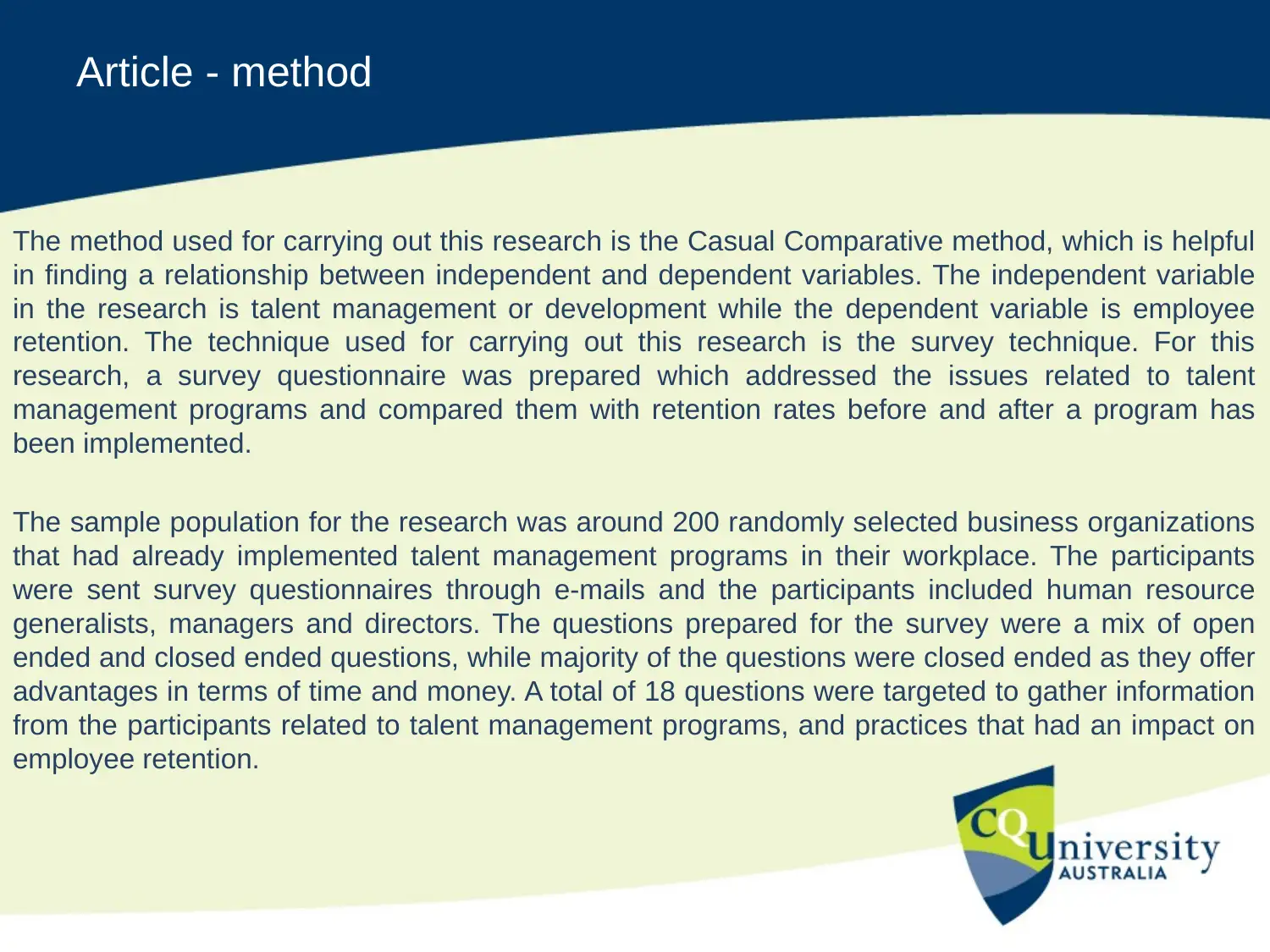
Article - method
The method used for carrying out this research is the Casual Comparative method, which is helpful
in finding a relationship between independent and dependent variables. The independent variable
in the research is talent management or development while the dependent variable is employee
retention. The technique used for carrying out this research is the survey technique. For this
research, a survey questionnaire was prepared which addressed the issues related to talent
management programs and compared them with retention rates before and after a program has
been implemented.
The sample population for the research was around 200 randomly selected business organizations
that had already implemented talent management programs in their workplace. The participants
were sent survey questionnaires through e-mails and the participants included human resource
generalists, managers and directors. The questions prepared for the survey were a mix of open
ended and closed ended questions, while majority of the questions were closed ended as they offer
advantages in terms of time and money. A total of 18 questions were targeted to gather information
from the participants related to talent management programs, and practices that had an impact on
employee retention.
The method used for carrying out this research is the Casual Comparative method, which is helpful
in finding a relationship between independent and dependent variables. The independent variable
in the research is talent management or development while the dependent variable is employee
retention. The technique used for carrying out this research is the survey technique. For this
research, a survey questionnaire was prepared which addressed the issues related to talent
management programs and compared them with retention rates before and after a program has
been implemented.
The sample population for the research was around 200 randomly selected business organizations
that had already implemented talent management programs in their workplace. The participants
were sent survey questionnaires through e-mails and the participants included human resource
generalists, managers and directors. The questions prepared for the survey were a mix of open
ended and closed ended questions, while majority of the questions were closed ended as they offer
advantages in terms of time and money. A total of 18 questions were targeted to gather information
from the participants related to talent management programs, and practices that had an impact on
employee retention.
Paraphrase This Document
Need a fresh take? Get an instant paraphrase of this document with our AI Paraphraser
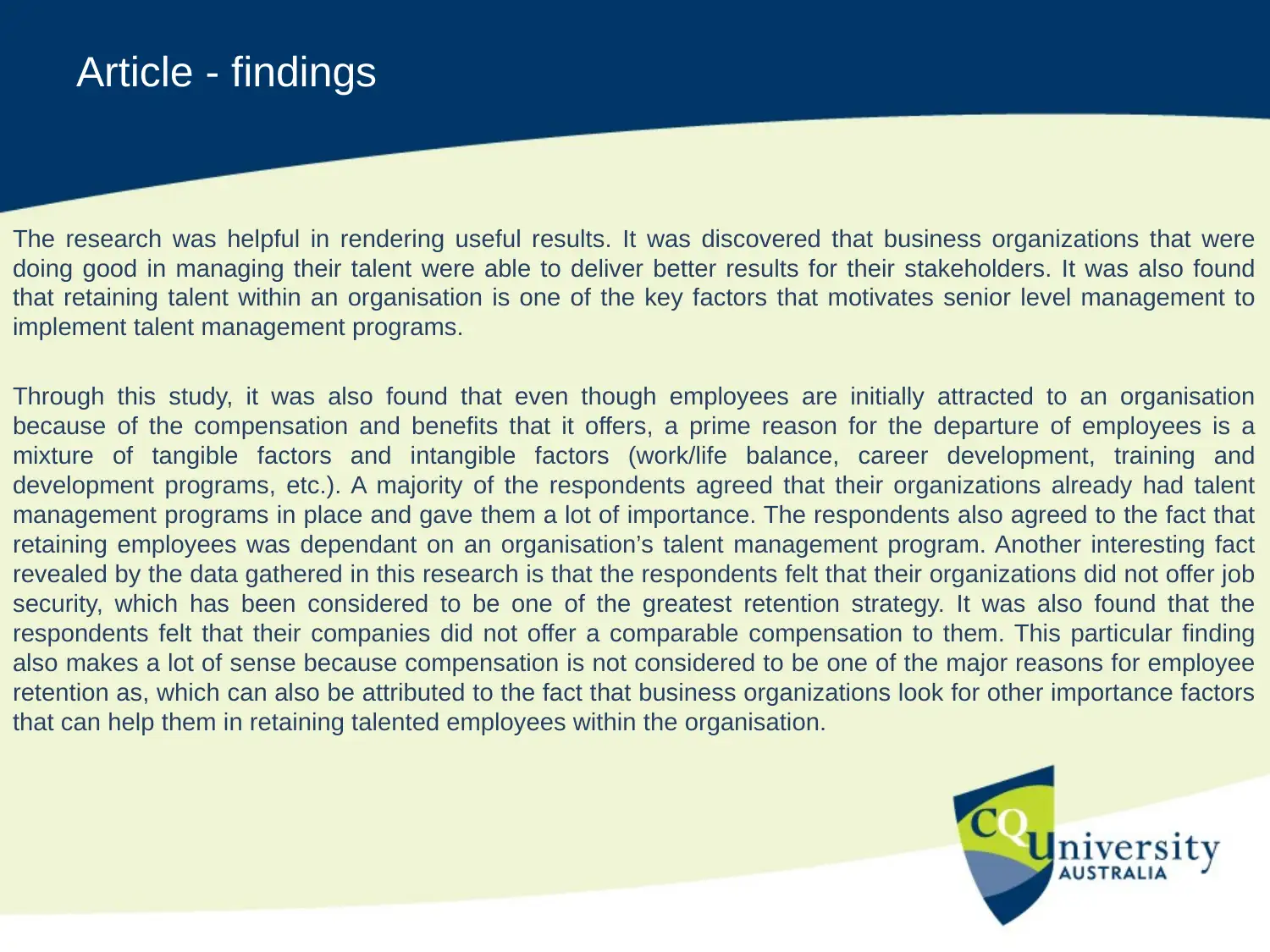
Article - findings
The research was helpful in rendering useful results. It was discovered that business organizations that were
doing good in managing their talent were able to deliver better results for their stakeholders. It was also found
that retaining talent within an organisation is one of the key factors that motivates senior level management to
implement talent management programs.
Through this study, it was also found that even though employees are initially attracted to an organisation
because of the compensation and benefits that it offers, a prime reason for the departure of employees is a
mixture of tangible factors and intangible factors (work/life balance, career development, training and
development programs, etc.). A majority of the respondents agreed that their organizations already had talent
management programs in place and gave them a lot of importance. The respondents also agreed to the fact that
retaining employees was dependant on an organisation’s talent management program. Another interesting fact
revealed by the data gathered in this research is that the respondents felt that their organizations did not offer job
security, which has been considered to be one of the greatest retention strategy. It was also found that the
respondents felt that their companies did not offer a comparable compensation to them. This particular finding
also makes a lot of sense because compensation is not considered to be one of the major reasons for employee
retention as, which can also be attributed to the fact that business organizations look for other importance factors
that can help them in retaining talented employees within the organisation.
The research was helpful in rendering useful results. It was discovered that business organizations that were
doing good in managing their talent were able to deliver better results for their stakeholders. It was also found
that retaining talent within an organisation is one of the key factors that motivates senior level management to
implement talent management programs.
Through this study, it was also found that even though employees are initially attracted to an organisation
because of the compensation and benefits that it offers, a prime reason for the departure of employees is a
mixture of tangible factors and intangible factors (work/life balance, career development, training and
development programs, etc.). A majority of the respondents agreed that their organizations already had talent
management programs in place and gave them a lot of importance. The respondents also agreed to the fact that
retaining employees was dependant on an organisation’s talent management program. Another interesting fact
revealed by the data gathered in this research is that the respondents felt that their organizations did not offer job
security, which has been considered to be one of the greatest retention strategy. It was also found that the
respondents felt that their companies did not offer a comparable compensation to them. This particular finding
also makes a lot of sense because compensation is not considered to be one of the major reasons for employee
retention as, which can also be attributed to the fact that business organizations look for other importance factors
that can help them in retaining talented employees within the organisation.

Article - conclusion
The changing demographics has definitely had an impact on the business scenario and
business organizations have started facing a difficulty in replacing their knowledgeable and
talented workers. Many business organizations in America have already started feeling a
shortage in their talent as a result of which they have started giving a greater priority to
attraction, recruitment, development and retention of employees. HR personnel included in
the study themselves recognized that retention of talented employees is imperative for the
success of a business organisation and talent management & development strategies would
definitely render positive results in the long run. Even the HR department personnel
recognized the dependency of employee retention rates on the talent management strategies
implemented by an organisation.
For future studies and research, it is recommended to determine all of the potential factors
that can have an impact on the talented retention rates in an organisation, which was not
done in this particular research. In a number of questions, the respondents used ‘other’ as an
answer, which is an indication that there are a wider number of factors that should have been
included in the questionnaires.
The changing demographics has definitely had an impact on the business scenario and
business organizations have started facing a difficulty in replacing their knowledgeable and
talented workers. Many business organizations in America have already started feeling a
shortage in their talent as a result of which they have started giving a greater priority to
attraction, recruitment, development and retention of employees. HR personnel included in
the study themselves recognized that retention of talented employees is imperative for the
success of a business organisation and talent management & development strategies would
definitely render positive results in the long run. Even the HR department personnel
recognized the dependency of employee retention rates on the talent management strategies
implemented by an organisation.
For future studies and research, it is recommended to determine all of the potential factors
that can have an impact on the talented retention rates in an organisation, which was not
done in this particular research. In a number of questions, the respondents used ‘other’ as an
answer, which is an indication that there are a wider number of factors that should have been
included in the questionnaires.
⊘ This is a preview!⊘
Do you want full access?
Subscribe today to unlock all pages.

Trusted by 1+ million students worldwide
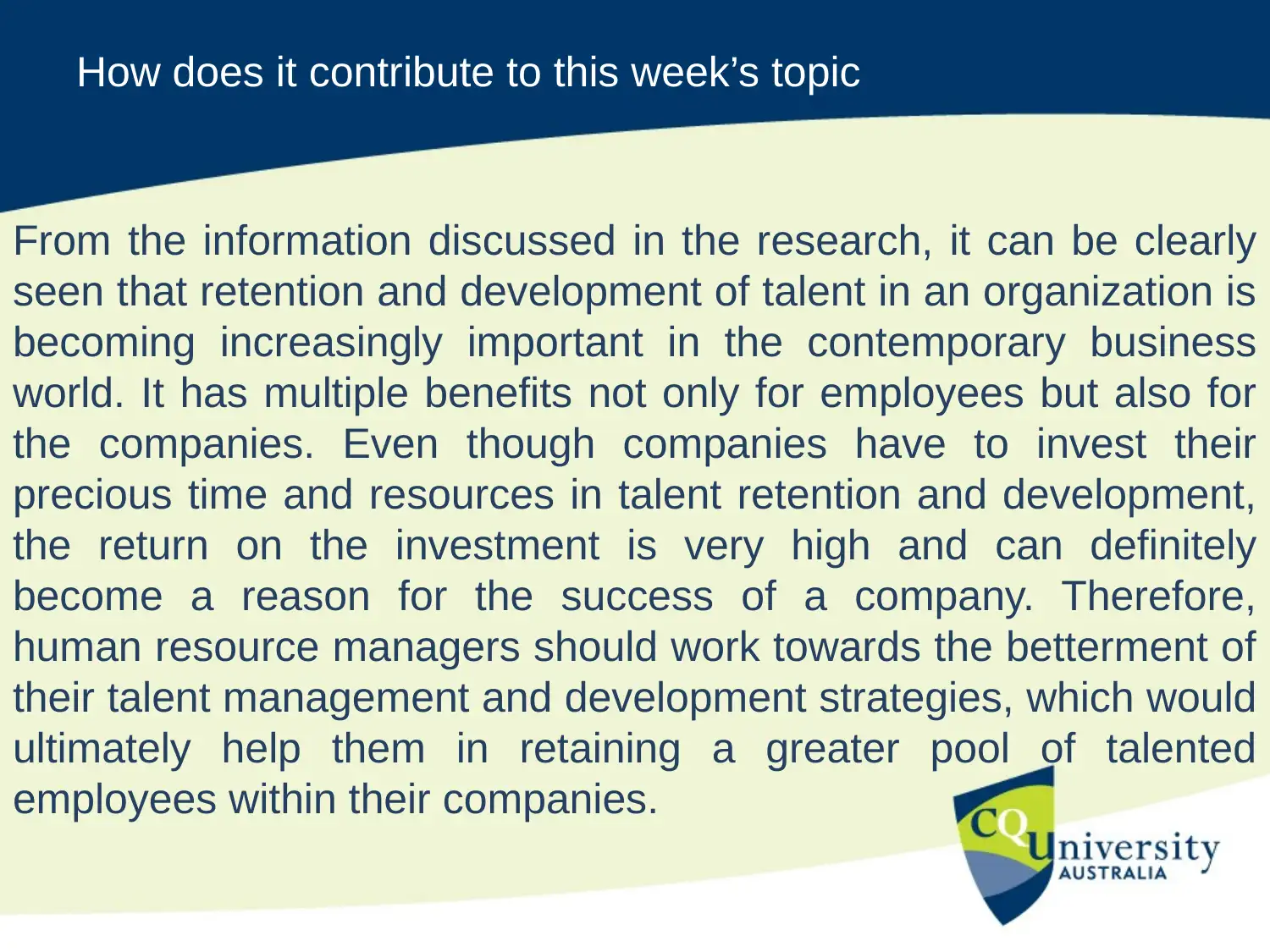
How does it contribute to this week’s topic
From the information discussed in the research, it can be clearly
seen that retention and development of talent in an organization is
becoming increasingly important in the contemporary business
world. It has multiple benefits not only for employees but also for
the companies. Even though companies have to invest their
precious time and resources in talent retention and development,
the return on the investment is very high and can definitely
become a reason for the success of a company. Therefore,
human resource managers should work towards the betterment of
their talent management and development strategies, which would
ultimately help them in retaining a greater pool of talented
employees within their companies.
From the information discussed in the research, it can be clearly
seen that retention and development of talent in an organization is
becoming increasingly important in the contemporary business
world. It has multiple benefits not only for employees but also for
the companies. Even though companies have to invest their
precious time and resources in talent retention and development,
the return on the investment is very high and can definitely
become a reason for the success of a company. Therefore,
human resource managers should work towards the betterment of
their talent management and development strategies, which would
ultimately help them in retaining a greater pool of talented
employees within their companies.
1 out of 7
Related Documents
Your All-in-One AI-Powered Toolkit for Academic Success.
+13062052269
info@desklib.com
Available 24*7 on WhatsApp / Email
![[object Object]](/_next/static/media/star-bottom.7253800d.svg)
Unlock your academic potential
Copyright © 2020–2025 A2Z Services. All Rights Reserved. Developed and managed by ZUCOL.





